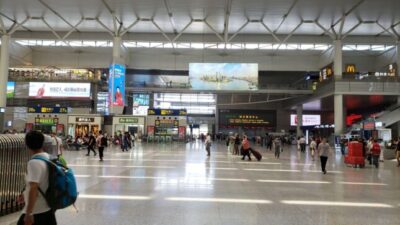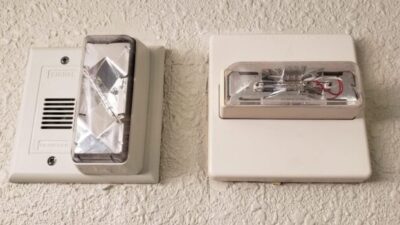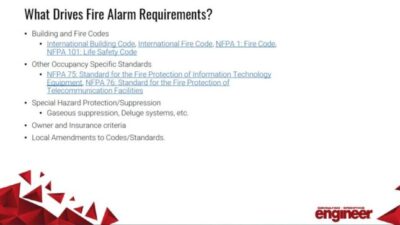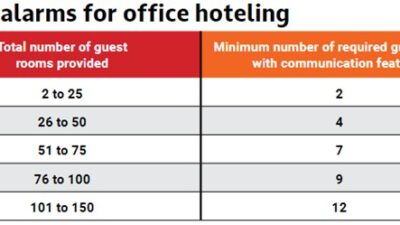Computational fluid dynamics is the latest and greatest when it comes to designing smoke management systems. But it's a complicated tool that's not necessary for every project. CONSULTING-SPECIFYING ENGINEER: Smoke management is an area where fire protection and mechanical engineers truly interface. Software for fire modeling and computational fluid dynamics make for even more exciting interfac...
Computational fluid dynamics is the latest and greatest when it comes to designing smoke management systems. But it’s a complicated tool that’s not necessary for every project.
CONSULTING-SPECIFYING ENGINEER: Smoke management is an area where fire protection and mechanical engineers truly interface. Software for fire modeling and computational fluid dynamics make for even more exciting interface possibilities. That said, these e-tools likely aren’t something that all designers are familiar with. How and why would you convince your brethren to get up to speed?
McGRATTAN: First, engineers need to understand the benefits: better visualization, some support for CAD, faster run times, better user interfaces and more validation support.
BARNETT: CFD software can also be used to gain insight into fire growth and its impact on structures and other enclosures. This software is especially useful with performance-based design for smoke control systems and has promise for use in the selection of materials for construction. The biggest challenge is determining the specifics of the model fire. While models predict the production and spread of smoke, the predictions are based on the size of the fire—something determined by the user.
CSE: Let’s step back and define exactly what CFD involves.
PUCHOVSKY: CFD modeling is typically used to determine the production, movement and temperature of smoke as a function of time and space for a specific volume of a building. In some instances, models are used in determining the amount of smoke that needs to be exhausted. In other situations, the models may be used to study various pressure differentials—for example, across the boundaries of exit stair enclosures.
BARNETT: There are also other types of models and packages, including finite element programs for structural fire-protection and egress prediction modeling. Even more common is the software used for sprinkler and other suppression system design.
PUCHOVSKY: It also helps to know where we’re coming from. Traditional fire-protection software, such as zone models, divides a building space into upper and lower layers and a fire plume. Algebraic equations can also be used to approximate fire and smoke behavior.
But with CFD modeling, the space in question is approximated by a large number of three-dimensional cells. The appropriate calculations pertaining to heat, mass and momentum transfer are then conducted between the individual cells. Through the use of a large number of small cells, CFD models allow for the examination of a particular situation in much greater detail than can be accomplished through zone models and algebraic equations. Additionally, CFD models can account for the impact of irregular shapes and unusual air movements that cannot otherwise be addressed.
CSE: OK, so how does one interpret this information?
PUCHOVSKY: Usually coupled with the CFD model is a visualization program that displays the results of the calculations. These programs produce vivid and dynamic graphical representations of the production, movement and temperature of smoke in a given space. This graphical output, along with the level of detail provided by the CFD calculations, is especially helpful in studying complex building geometries and unique architectural features, and in presenting results and areas of concern to the design team and enforcement officials.
CSE: What do mechanical engineers need to understand about this modeling process?
SAAH: The most important thing these models provide is the quantitative component of the design that will ultimately be used to meet the life-safety goal. For example, atrium smoke exhaust systems are designed to maintain a prescribed smoke layer height. The fire-protection engineer will use a software program to determine the volume of smoke required to be exhausted in order to meet this life-safety goal.
But it’s equally important for the mechanical engineer to understand the limitations of the software, especially with respect to the user’s ability to interpret data input correctly, understand the program capabilities and understand the technical output.
PUCHOVSKY: Furthermore, the design team must also determine whether CFD analysis is even necessary. In many cases, zone models and algebraic equations are adequate. The soon-to-be-published 2005 edition of NFPA 92B, Standard for Smoke Management Systems in Malls, Atria, and Large Spaces , includes new information on the use of zone models and CFD models, as well as updated application examples.
CSE: Tell us about hardware and other user requirements.
PUCHOVSKY: CFD models usually require large-capacity computers in terms of memory and processor speed, and advanced expertise to operate and interpret. To obtain accurate results and to adequately represent large complex spaces, the size of the individual cells used to approximate the entire space or the areas of concern should be small. This results in a large number of cells which, in turn, creates a large input file. While this can produce more accurate results, it also requires more computer time. In a nutshell, mechanical engineers should be aware that, depending upon the situation, a single CFD run can require several days of computer processing time.
CSE: What kind of software is out there? Does it need to be customized?
PUCHOVSKY: A number of off-the-shelf CFD models are available, but most require modification for the study of fire effects and smoke movement. Once modified, some level of validation should be conducted to ensure that the physics associated with fire and smoke behavior are correct. One program, called the Fire Dynamics Simulator (FDS), was developed specifically for fire applications and has been used for the design of smoke management systems, sprinkler and detector activation studies and in fire reconstruction. FDS, which has undergone some degree of validation, is in the public domain and can be obtained from NIST.
CSE: What should engineers be wary of when using this design software?
McGRATTAN: Accuracy is a concern. When using CFD sofware, errors in calculation often come from using a coarse mesh. A user should validate results with some experimental data or empirical correlation. For example, there are simple formulas that can be used to predict the descent of a smoke layer in a simple space. In a nutshell, validation is vital.
PUCHOVSKY: Actually, the need for CFD analysis on a given project needs to be justified. While providing more detailed results in some cases, it may not be necessary—and will require more effort and increase the overall design cost of the project. But at times, the increased cost may be justified if it preserves design vision or results in cost savings elsewhere in the project. In some cases, because of the geometry of the space in question, CFD analysis provides the most accurate approximation of smoke development and movement. It should also be verified that the engineers conducting the CFD computer modeling and subsequent analysis have the necessary equipment and expertise.
CSE: In what are ways do fire-protection and mechanical engineers most effectively work together?
McGRATTAN: It sounds silly, but it’s important to use the same units and talk the same language. Any fire-specific quantity, like the RTI (response time index) of a sprinkler, should be explained using commonly understood concepts such as heat transfer, fluid dynamics and chemistry. Also, the engineers should stick with basic thermodynamic quantities.
BARNETT: Fortunately, many fire-protection engineers have a background in mechanical engineering, so there is often a pre-existing understanding of issues. However, for mechanical engineers not familiar with fire protection, the biggest challenge is explaining to them the stochastic nature of fire; the difficulty of designing for people movement; the uncertainty of fuel quantity, location and burning characteristics; and the differences between prescriptive- and performance-based designs.
SAAH: A fire-protection engineer has the technical background in fire dynamics and smoke production; the mechanical engineer is an expert at designing air movement systems. The coordination of the two disciplines is necessary for proper design of smoke control systems. For example, the fire-protection engineer will provide volumetric exhaust rates and the performance requirements for smoke-control system survivability to the mechanical engineer, who will, in turn, design a system around these criteria.
That being said, another design team member that needs to be part of the equation is the architect. Sometimes, simple architectural modifications can result in a substantial reduction in the smoke control requirements. Mechanical engineers, therefore, must understand architectural design features and be able to offer design suggestions.
CSE: Speaking of the building team as a whole, where do local code authorities stand on the use of CFD?
PUCHOVSKY: Computer models usually accompany the application of performance-based design to verify that a proposed design solution satisfies the code’s stated safety goals.
While it is expected that prescriptive designs will continue as the predominant design method for most projects, the performance-based design option provides for a formalized approach for dealing with such design approaches and provides a framework for both designers and code enforcers. In addition, the performance-based design approach can also be applied when developing an equivalency to prescriptive requirements.
CSE: How useful is fire modeling software for designs that follow prescriptive codes?
SAAH: Fire modeling can either support the prescriptive code requirement or it can show that the prescriptive requirement is too restrictive—or too lenient. For example, in underground building smoke-exhaust systems, fire modeling may indicate that a minimum of six air changes per hour is insufficient.
PUCHOVSKY: The question is moot in that when designing smoke-management systems for large spaces, prescriptive requirements, in the traditional sense, are not usually relevant. Most building regulations no longer specify or prescribe that the smoke-management system be sized to exhaust a certain number of air changes per hour based upon the volume of the space. The design of these systems is largely based on calculation methodologies. Therefore, NFPA 92B can be considered a performance-based document because the size of the smoke management system is based on calculation methodologies that verify if specific performance criteria are satisfied for specific fire scenarios. As such, computer models, whether they take the form of sophisticated CFD models, zone models or calculation spreadsheets, become essential tools in the design of any smoke-management or smoke-control system.
Participants
Dr. Jonathan Barnett , Professor, Fire Protection Engineering Worcester, Polytechnic Institute, Worcester, Mass.
Milosh Puchovsky , P.E., Principal Fire Protection Engineer, National Fire Protection Assn., Quincy, Mass.
Isa Y. Saah , P.E., Principal The Protection Engineering Group, PC, Chantilly, Va.
Kevin McGrattan , Mathematician Building and Fire Research Lab NIST, Gaithersburg, Md.
Fire-Protection Engineer, At Your Service
Generally, the larger the heat-release rate, the greater the amount of smoke exhaust required. Fire-protection engineers must determine what impact fire location has on smoke production, the effect of sprinklers on reducing fire size, whether fire-growth rate accurately represents the fuel packages anticipated and the likelihood that a fire will spread from the initial fuel package to adjacent combustibles. Most applications of computer fire models are not intended to predict fire growth and spread. This information serves as an input variable and needs to be determined before the program is run.
Additionally, fire-protection engineers can ensure that associated phenomena such as smoke layer stratification and plugging up holes are adequately accounted for in the design, and that the number and location of make-up air inlets are optimized. They can also provide guidance on what effect architectural features, such as balconies and exit location, can have on the overall smoke-management system, and provide recommendations on the type of fire-detection devices that are best suited for activation and response of a smoke-management system.
Where a smoke-exhaust system is designed so that the smoke layer is maintained above the heads of building occupants, or designed so that occupants can move through some concentration of smoke, fire-protection engineers have specific knowledge regarding tenability and visibility criteria, as well as occupant movement during fire situations. All of these factors can have a significant effect on the performance and effectiveness of the smoke-management system.



